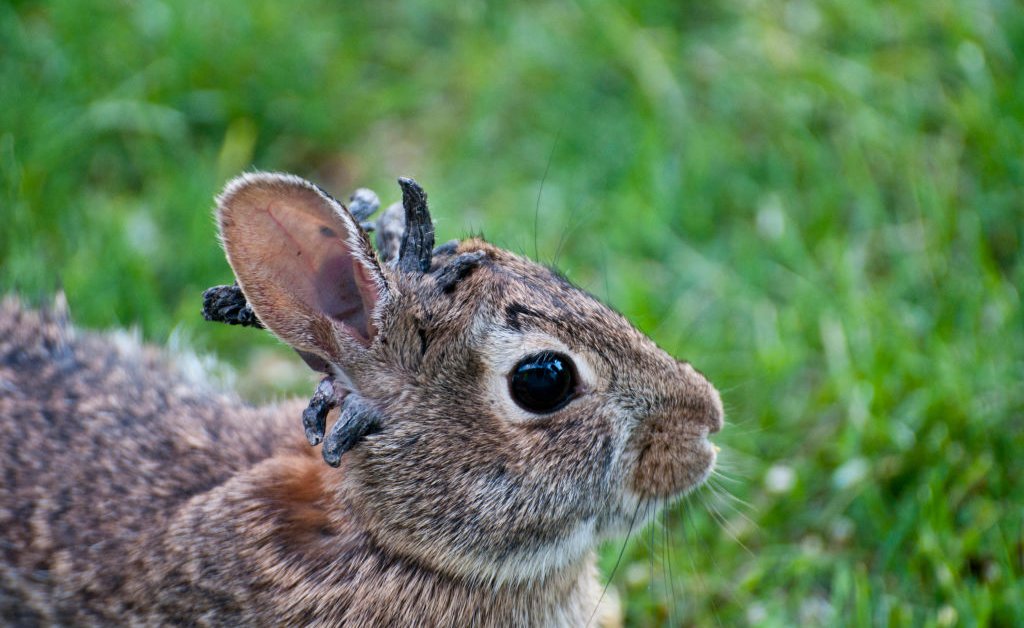On Aug. 8, the calls started rolling in to Colorado Parks and Wildlife: Scary-looking rabbits were hopping around Fort Collins. These weren’t your standard cute, fluffy bunnies; they had horn-like growths protruding from their faces and bodies. People on social media described them as “zombie” and “demon” rabbits and noted their resemblance to Frankenstein. One Fort Collins resident told a local news station that she had seen a rabbit that looked like it had “black quills or black toothpicks sticking out all around his or her mouth.”
The rabbits didn’t hop out of the set of a horror flick: They have cottontail rabbit papillomavirus, a skin disease that leads to alarming-looking growths. “It exhibits as these wart-like growths on their face—sometimes they’re smaller, like little nodules, and sometimes they’re bigger, like tentacles or horns,” says Kara Van Hoose, a spokesperson with Colorado Parks and Wildlife.
We asked experts what the virus is, how it affects rabbits, and if humans should be concerned.
What exactly is the rabbit papillomavirus?
The rabbit papillomavirus—which is most frequently seen in the Midwest—was identified by the cancer researcher Richard E. Shope in the 1930s. (It’s also known as the Shope papillomavirus.) It has since been used as a model to help scientists study the human papillomavirus, or HPV, which can similarly cause genital warts and lead to certain types of cancer.
Rabbits get the virus when they’re bitten by ticks, fleas, and mosquitoes, and can spread it to each other through direct contact. Infection tends to be seasonal: It’s especially common in the summer, when biting insects are most active. “We go through this every year,” Van Hoose says. Factors like warm weather and a bad mosquito season (which is the case this summer in Colorado) can influence how prevalent papillomavirus is each year.
Read More: 6 Things to Eat to Reduce Your Cancer Risk
The virus causes warty, black lesions around the neck and shoulders in wild cottontail rabbits, and around the ears and eyelids in domestic rabbits, says A. Alonso Aguirre, dean of Colorado State University’s Warner College of Natural Resources and an expert in wildlife diseases. Sometimes, it shows up as a tumor on rabbits’ legs, especially on the surface of their hind feet. These tumors are firm, white, and moist on the surface, Aguirre says, and generally persist for up to 150 days—and then disappear. “It’s very painful,” he adds.
Can rabbits recover?
Despite the gruesome way it looks, cottontail rabbit papillomavirus is often benign, and many rabbits end up fighting it off on their own. Research suggests that in about 35% of affected rabbits, papillomas simply disappear within six months. Cottontail rabbits typically aren’t treated. “I don’t know if you’ve ever tried to capture a rabbit, but it’s very difficult,” Van Hoose points out. “They’re very fast.”
In other cases, however, the protrusions can affect the rabbits’ eyes and mouth, preventing them from being able to eat, drink, or see clearly. That can lead to starvation and other life-ending complications, Van Hoose says. The virus can also turn into squamous cell cancer with metastases.
While wild rabbits mostly just develop warts when infected with cottontail papillomavirus, domestic rabbits experience much more severe illness, says Thomas M. Donnelly, a veterinarian who specializes in laboratory animal medicine and has studied the virus. The majority develop invasive epidermoid carcinomas (meaning they begin in squamous cells), he says, which are typically fatal.

Is there any risk to humans? What about other animals?
The rabbit papillomavirus only affects hares and can’t be transmitted to humans or other types of animals. Still, Colorado Parks and Wildlife has instructed residents not to touch or otherwise attempt to help infected rabbits. “That’s what we tell everyone with wildlife,” regardless of whether the animals are sick, Van Hoose says. “It’s just practicing those really smart wildlife principles of keeping your distance, not feeding them, and not trying to step in and help, because there’s nothing we can really do.”
A public frenzy
It makes sense why people are so intrigued by the horned rabbits. They’re unusual and weird-looking; plus, rabbits are prevalent in many neighborhoods, says Valerie McKenzie, a professor in the department of ecology and evolutionary biology at the University of Colorado. “You’re used to seeing, ‘Oh, cute bunny,’” she says. “Now it’s, ‘Oh my gosh, crazy bunny with these things all over it.’”
While the horned rabbits are currently captivating wildlife observers, the virus isn’t the only unique way disease can show up in animals, she adds: “There’s all kinds of parasites and diseases that cause wild things in animals, that are really kind of cool and exciting.” McKenzie hopes the viral nature of the Colorado “zombie rabbits” inspires more research to better understand the disease.
Read More: What an HPV Diagnosis Really Means
It’s been interesting to see the spectrum of reactions play out, Van Hoose says. “Some people think they look really gross, and they’re weirded out by the growths on their face—they don’t really want to see it,” she says. “Other people, myself included, think it looks kind of metal and kind of cool.”
It’s unclear exactly how many infected rabbits are hopping about, but Colorado Parks and Wildlife has received more than a dozen sightings, mostly in the northern part of the state. Since the initial reports, Van Hoose has spent her days on the phone, talking to reporters clamoring for information about the rabbit papillomavirus. “This is one of the busiest days I’ve had at Colorado Parks and Wildlife,” she told TIME on Aug. 13. The end of the summer is typically the agency’s most hectic time of year anyway, as people flock to the area’s outdoor attractions. “Every day there’s a new wildlife question that comes in, and that includes dealing with bears and an invasive bighead carp species that we pulled out of a small pond,” she says. “I didn’t think that rabbits would become our most interesting story.”
Van Hoose hasn’t seen an infected rabbit yet, but she hopes that changes soon: “I feel like I’m kind of owed one now, since I’ve been talking about it so much,” she says.








